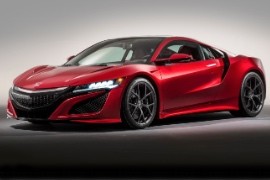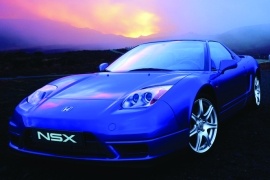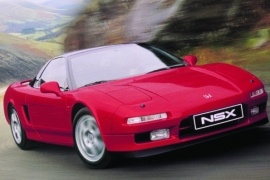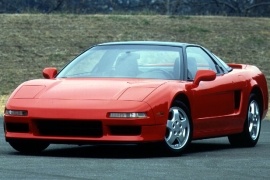HONDA NSX Models/Series Timeline, Specifications & Photos
First production year: 1991
Engines: Hybrid, Gasoline
Body style: Coupé (two-door)
Honda didn't want to disappoint its customers when it announced that it would launch a new generation for the famous NSX and waited ten years before introducing the second generation of this nameplate at the 2015 North American International Auto Show.
The three letters stood for New Sportscar eXperimental, and it was used for the first time on the supercar's first generation in 1990 for the 1991 model-year. It was a huge bet for Honda, and it worked. It was a daily driver supercar, and it proved worthy, especially after it was finely tuned by the legendary Formula 1 driver Ayrton Senna. With such high expectations, there's no wonder that Honda delayed the introduction of the NSX's second generation until 2015. But when it arrived, it stirred emotions until the last unit rolled out of the assembly line in 2022. The NSX was sold under the Honda badge for specific markets, while other countries knew it as Acura.
Like its predecessor, the 2016 NSX was a mid-engined car with a short nose. Still, it featured an angular front fascia that sported slim LED headlights and a pentagonal-shaped grille flanked by broad side scoops. From its profile, the greenhouse sported an arched roofline that sloped down to the back of the vehicle, covering the engine compartment. In front of the rear wheel arches, the automaker installed the air intakes needed to cool the engine and feed it with air. Finally, at the back, Honda's design team installed LED taillights linked with a red strip.
Despite the sporty exterior look, the cabin was luxurious. Even though it featured high-bolstered seats, these provided both comfort and side support. Between the car's occupants, the automaker installed a tall center console that hosted the buttons for the gearbox. There wasn't any shift lever or gear selector. Fronting the driver was a TFT that showed the speedometer in digits inside the round tachometer.
The powertrain consisted of a twin-turbocharged 3.5-liter V6 helped by three motors: two at the front and one in the rear. Thanks to this setup, the car entered the supercar territory, even though the automaker said that it was mostly a gran tourer.
The Honda/Acura NSX was the first internationally acclaimed Japanese supercar. It was unveiled in 1990, and it had two facelifts along its way.
There is so much to say about the NSX, the supercar built by the same carmaker that made the Civic or the Jazz/Fit. But few things must be said to understand how important that car was. It was a theme inspiration for Gordon Murray when he designed the McLaren F1 supercar, and it was the only vehicle that benefited from the experience of one of the greatest racing drivers in the world, Ayrton Senna. Honda introduced it in 1990 with a 3.0-liter V6 engine. Seven years later, it increased the displacement to 3.2-liter. The final upgrade was made in 2002.
Between 1990 and 2002, the automotive trend was changed, and carmakers gave up the pop-up headlights. Honda did the same and installed a new set fitted with HID lamps, which doubled the lumen power (light power). The front bumper was extended and lowered, increasing the downforce. There was a new set of taillights and a lip-spoiler on top of the trunk-lid in the rear. All these upgrades made the car quicker to 125 mph (201 kph) by 0.2 seconds and increased the top speed from 168 mph (270 kph) to 175 mph (285 kph).
The interior received some mild upgrades for the trims and upholstery. But it featured the same classic Honda layout for the instrument cluster, which could have been seen on the Accord or Civic.
Three years after that update, Honda withdrew the NSX from the assembly line. The all-aluminum bodywork and the complex powertrain led to a price much higher than its competitors, without beating them on the track.
When Honda introduced the NSX in 1991, it sent a massive shockwave in the motoring industry and proved that a supercar could be used as a daily driver and, in 1997, it improved the vehicle.
The three letters from its nameplate came from New Sportscar eXperimental, and it featured a unit body built from aluminum. Its mid-mounted engine and the independent suspension in all corners made the car very agile. When the pre-production car was ready, the legendary Formula 1 pilot Ayrton Senna drove the NSX, and, in a few words, he sent back the engineering team to improve the car and delayed the launch of the production model for eight months. But the final result exceeded everyone's expectations and improved the car's rigidity by 50%. By 1997, the NSX was globally known, and the customers asked for more straight-line performance, not only excellent handling.
For the 1997 model, Honda made a few changes to the bodywork. For starters, it replaced the front bumper and included a wider central grille. The most significant change was for the greenhouse. On the original version, the NSX sported black pillars and roof, while after 1997, they were body-colored. A new set of light-alloy wheels made it on the options list.
Inside, there was a slight change on the instrument panel, which was no longer black as on the original version. The carmaker also offered a choice for steering wheels. Other than that, it was the same user-friendly interior that Honda produced for the 1991 NSX.
The most significant improvement on the car was the drivetrain. Honda introduced a new, 3.2-liter V-6 engine paired to a six-speed manual. For the automatic version, the carmaker kept the older setup with a 3.0-liter and a four-speed gearbox.
It was unusual for a mass-market automaker to create a supercar, but Honda did it anyway and in 1990 unveiled the NSX; New Sportscar eXperimental.
Soichiro Honda was still alive when the car was launched. Even though he was too old to participate in the car's development, his team made this dream possible. Honda aimed to create a daily driver supercar. It aimed at the famous Ferrari 348, and the result was stunning. Even the famous Formula 1 Champion Ayrton Senna contributed to the car's development.
The car was unveiled at the 1989 Chicago Auto Show. It wasn't 100% ready for the production line. The initial styling was made at the Pininfarina styling center in Italy, and the greenhouse was inspired by the F16 jet fighter. The use of aluminum shaved 200 kg (440 lbs) from the body weight. The car featured aluminum independent suspension for the front and rear. The pop-up headlights were installed in the non-facelift version.
Inside, the NSX featured two low-mounted sport bucket seats that hugged their occupants and kept them safe during high-speed cornering. The instrument cluster followed the same design as the Accord from the same era. It wasn't anything fancy.
Initially, the car was studied with a 2.0-liter V6 engine, but the idea was abandoned in favor of a 3.0-liter VTEC engine, which was used until 1997, when a new 3.2-liter unit was installed.
The standard transmission was a 5-speed manual, and in 1994 a 4-speed automatic with sequential manual shifting was available.
Honda NSX was considered the first Japanese everyday supercar due to its reliability and ease of driving. In the U.S., it was sold under the Acura badge.



